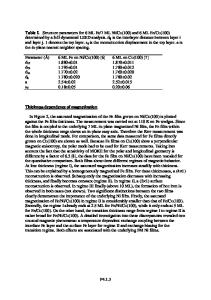Silicide Formation for Ni and Pd Bilayers on Si(100) Substrates
- PDF / 357,507 Bytes
- 6 Pages / 595 x 842 pts (A4) Page_size
- 10 Downloads / 245 Views
Silicide Formation for Ni and Pd Bilayers on Si(100) Substrates Xin-Ping Qu, C. Detavernier, R. L. Van Meirhaeghe and F. Cardon Dept. of Solid State Science, Gent University, Krijgslaan 281/S1, Gent, Belgium ABSTRACT The silicide formation for Ni/Pd and Pd/Ni bilayers on Si(100) substrates was investigated. X-ray diffraction and photoelectron spectroscopy (XPS) depth profiling have been applied to study the phase formation of the silicide. We found that with addition of Pd into Ni/Si, a uniform layer of ternary Ni1-xPdxSi layer formed and kept stable for a wide temperature range. The lattice parameter of Ni1-xPdxSi as a function of Pd addition was calculated. The nucleation temperature of NiSi2 was delayed due to the addition of Pd. The higher the Pd addition, the larger the increase in NiSi2 nucleation temperature. We also studied the effect on the addition of Ni to the Pd/Si reaction. For pure Pd/Si reaction PdSi nucleated from Pd2Si at 750°C or above. For Ni/Pd/Si reaction, Pd2Si changed to Ni1-xPdxSi at temperature lower than 750°C due to the incorporation of Ni. The phenomena were explained by classic nucleation theory taking into account the effect of mixing entropy effect. INTRODUCTION Self-aligned silicide (Salicide) is widely used in integrated circuits to reduce polycrystalline silicon interconnects resistance and source-drain contact resistance. Nickel monosilicide (NiSi) is one of the most promising potential candidates to replace C54-TiSi2 for deep submicron MOSFET devices [1], since its sheet resistance remains unchanged for linewidth down to 0.1 µm. In addition, the consumption of Si is relatively low during the formation process of NiSi. However, NiSi is not stable. For processing temperatures go higher than 750°C, NiSi will transform into highly resistive NiSi2. The transformation of NiSi to NiSi2 is known to be nucleation controlled [2]. Furthermore, it has been shown that the NiSi2 nucleation temperature may be controlled by controlling the stress in the Si substrates [3] or adding alloying elements to the silicidation reaction [4-14]. Recently, it was shown that adding Pt into Ni could increase the nucleation temperature of NiSi2 to 900°C [4, 5], while adding Au into Ni will decrease the nucleation temperature of NiSi2 to 600°C [6]. Additions of other impurities were also studied, such as Co [6], Ti [7], Ir [8] etc. In this paper, we will discuss the effect of addition of Pd on the silicide formation. NiSi, PtSi and PdSi have the same crystallographic structure as orthorhombic MnP, which belongs to the Pnma space group. The Ni/Pd/Si system was first studied by T. G. Finstad [9]. EXPERIMENTAL P-type Si(100) wafers with a relative high substrate resistivity (Na = 1013~1014) were used as substrates. After standard chemical cleaning and a dip in a diluted HF solution, the wafers were loaded into the vacuum chamber. The base pressure is about 7×10-7 Torr. Ni and Pd were deposited without breaking the vacuum. Ni was electron-beam evaporated and Pd was sputtering deposited. The deposition rate for Ni an
Data Loading...











